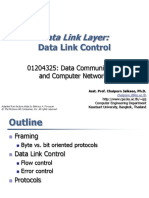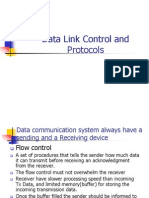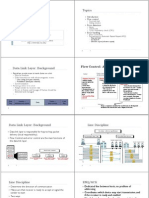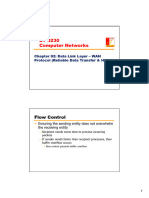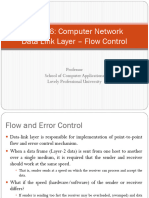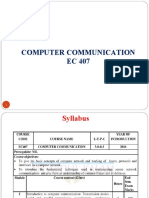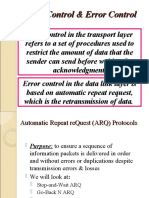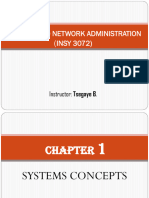Data Communication & Computer Networks
Data Link Layer
Data Link Control Responsible for node-
to-node (hop-to-hop)
communication.
The two main functions
of the data link layer are
{ Data link control
{ Media access control
Prof. Dr. Manzoor Hashmani
mhashmani@iqra.edu.pk MH 2
Data Link Control Framing
Deals with the design and procedures The data link layer packs bits into
for communication between two frames, so that each frame is
adjacent
j nodes ((node-to-node distinguishable
g from another.
communication) The data link layer adds a sender
Data link control functions include address and a destination address to
{ framing the frames.
{ flow control
{ error control
MH 3 MH 4
Framing Character-Oriented Protocols
Fixed-size framing
Data to be carried are 8-bit characters
{ no need for defining the boundaries of the
frames from a coding system such as ASCII
V i bl i fframing
Variable-size i Header and trailer are also multiples of
{ need a way to define the end of the frame
8 bits.
and the beginning of the next frame An 8-bit flag at the beginning and the
{ two approaches used for this purpose: end of a frame define frame boundaries
a character-oriented approach
a bit-oriented approach
MH 5 MH 6
1
� Bit-Oriented Protocols Flow Control
The data section of a frame is a
sequence of bits to be interpreted by Flow control refers to a set of
the upper layer as text, image, audio, procedures used to restrict the amount
video etc.
video, etc of data that the sender can send before
waiting for acknowledgment
Most protocols use a special 8-bit
pattern flag 01111110 as the delimiter Ensuring the sending entity does not
to define the frame boundaries overwhelm the receiving entity
{ Preventing buffer overflow (giving ample time
to the processor to process)
MH 7 MH 8
Error Control Model of Frame Transmission
Error control in the data link layer is
based on automatic repeat request,
which is the retransmission of data.
Automatic repeat request (ARQ)
{ Error detection (Damaged Frames, Lost Frames)
{ Positive acknowledgment
{ Negative acknowledgement and
retransmission
{ Retransmission after timeout
MH 9 MH 10
Data Link Control Noiseless Channel
Let us assume we have an ideal
channel in which no frames are lost,
duplicated,
p , or corrupted.
p
For such a channel we have…
{ Simplest Method (no flow control)
{ Stop-and-Wait Method (with flow control)
None of the above have error control as
they are for noiseless (ideal) channel
MH 11 MH 12
2
�Simplest Method Stop-and-Wait
The sender sends
one frame
Stops and Waits
until it receives
confirmation from
the receiver
Then sends the next
frame
Thus Flow Control
MH 13 MH 14
Stop-and-Wait Method Noisy Channel
In reality noiseless (error-free)
channels do not exist.
Therefore in noisy channel
Therefore, channel, we need
error control as well.
Error control in the data link layer is
based on Automatic Repeat Request
(ARQ).
MH 15 MH 16
Automatic Repeat Request
(ARQ) Stop and Wait ARQ
It is the simplest flow and error control
Stop and wait
mechanism
Source transmits frame & keeps a copyy
Go back N Destination receives frame and replies
with acknowledgement
Selective repeat Source waits for ACK before sending
next frame
MH 17 MH 18
3
�Stop and Wait ARQ Operation of Stop and Wait
If received frame damaged, discard it We can have four different situations
{ Transmitter has timeout in the transmission of a frame:
{ If no ACK within timeout, retransmit 1. Normal operation
Numbering the frames prevents the 2. Loss of frame
retaining of duplicate frames 3. Loss of ACK
{ ACK number defines the number of next 4. Delay of ACK
expected frame
{ Use ACK0 and ACK1
MH 19 MH 20
1. Normal Operation 2. Lost or damaged frame
Lost or damaged
frames are
handled in the
same manner (No
ACK)
MH 21 MH 22
3. Lost or damaged ACK 4. Delayed ACK
If ACK damaged
transmitter will not
recognize it
{ Transmitter will
retransmit
{ Receive gets two
copies of frame
{ Use ACK0 and
ACK1
MH 23 MH 24
4
� Piggybacking Go-back-N ARQ
In bidirectional transmission both parties keep record
of sent and expected frame numbers Stop-and-Wait ARQ is simple but inefficient
Piggybacking To improve efficiency multiple frames should
saves be in transition while waiting for ACK
bandwidth T
Transmitter
itt can send d W frames
f without
ith t ACK
(reduces A copy of each frame is kept until ACK arrives
overheads
like CRC,
Each frame is numbered
addresses, Sequence number bounded by size of field
etc.) { If frame header allows m bits for sequence
number, number range will be 0 to 2m - 1
MH 25 MH 26
Sender sliding window Receiver sliding window
Sender uses a window to hold frames until ACK The size of window at receiver is 1
Frames on left of window are acknowledged The receiver is always waiting for a specific
Frames on right can’t be sent until window frame to arrive in a specific order
slides over
MH 27 MH 28
Go-Back-N Control variables Go-Back-N Acknowledgment
Sender Variables
If no error, ACK as usual with next
S = recently sent frame Receiver has only 1
variable R that hold frame expected
SF=1st frame in window
the sequence no. of Receiver can send one cumulative
SL=last frame in window
p
the expected frame
W = Size of sliding window ACK ffor severall fframes
= SL – SF + 1
If error,
{ Discard that frame and all future frames
until error frame received correctly
{ Transmitter must go back and retransmit
that frame and all subsequent frames
MH 29 MH 30
5
� Operation of Go-back-N 1. Normal Operation
We can have four different situations
in the transmission of a frame:
1. Normal operation
2. Loss of frame
3. Loss of ACK
4. Delay of ACK
MH 31 MH 32
2. Lost or damaged frame
3. Lost or delayed ACK
If next ACK arrives before expiration of
any timer then no retransmission
If next ACK arrives after timeout,
timeout the
frame and all later frames will be
retransmitted.
MH 33 MH 34
Sender window size Piggybacking
Go-back-N ARQ can also be
bidirectional and can also use
piggybacking
p ggy g to improve
p efficiency
y
In such a case, each direction needs
both sender window and a receiver
window
In Go-Back-N ARQ, the size of the
sender window must be less than 2m.
MH 35 MH 36
6
�Selective Repeat ARQ Sender and Receiver windows
Control variables same as Go-back-N
Go-back-N ARQ Window size at most half of 2m (W <= 2m-1)
{ simplifies the process at receiver site
Receiver expects a “range” of frames
{ very inefficient for a noisy channel
-ve ACK (NAK) reports the sequence number
(resending many frames when only one
of the damaged frame
was damaged)
Selective Repeat ARQ
{ Processing at receiver is complex
{ More efficient for noisy links (resends
damaged frames only)
MH 37 MH 38
Lost frame
Sender and Receiver windows
MH 39 MH 40
Sender window size Piggybacking
Selective Repeat ARQ can also be
bidirectional and can also use
piggybacking
p ggy g to improve
p efficiency
y
In such a case, each direction needs
both sender window and a receiver
window
MH 41 MH 42
7
� Bandwidth-Delay Product Example
In a Stop-and-Wait ARQ system, the bandwidth of the line
is 1 Mbps, and 1 bit takes 20 ms to make a round trip. What
Efficiency of an ARQ system can be is the bandwidth-delay product? If the system data frames
measured by the product of bandwidth are 1000 bits in length, what is the utilization percentage of
the link?
((bps)
p ) and round-trip
p delay
y ((sec))
Solution
It is a measure of the number of bits
The bandwidth-delay product is
that can be sent out of a system while
1 × 106 × 20 × 10-3 = 20,000 bits
waiting for ACKs
The system can send 20,000 bits during the time it takes for the data to
go from the sender to the receiver and then back again. However, the
system sends only 1000 bits. We can say that the link utilization is only
1000/20,000, or 5%. For this reason, for a link with high bandwidth or long
MH 43 delay,
MH use of Stop-and-Wait ARQ wastes the capacity of the link. 44
Example HDLC
What is the utilization percentage of the link in the
previous example if the link uses Go-Back-N ARQ Configurations and Transfer Modes
with a 15-frame sequence? Frame Format
Solution Frame Types
The bandwidth-delay product is still 20,000. The
Examples
system can send up to 15 frames or 15,000 bits during Data Transparency
a round trip. This means the utilization is
15,000/20,000, or 75 percent. Of course, if there are
damaged frames, the utilization percentage is much
less because frames have to be resent.
MH 45 MH 46
HDLC Configurations & Transfer Modes
1. NRM – Normal Response Mode
High-level Data Link Control
{ Station configuration is unbalanced
A bit-oriented protocol for
communication over point-to-point
point to point and
multipoint links.
It implements the ARQ mechanisms
discussed before
MH 47 MH 48
8
�Configurations & Transfer Modes Frame Format
2. ABM – Asynchronous Balanced Mode
Each frame in HDLC may contain up
{ Station configuration is balanced
{ Point-to-point link
to 6 fields
{ Each station can function as primary and
secondary
Frame Check Sequence
MH 49 MH 50
Frame Format Frame Format
Flag Field Address Field
{ Contains an 8-bit sequence 01111110 { When primary/secondary configuration is
{ Used to identify beginning and end of a used, it contains address of the
frame secondary
d station
t ti
{ Serves as a synchronization pattern for { When primary/secondary configuration is
the receiver not used, it contains source and
{ In multiple frame transmissions, the destination addresses
ending flag of one frame can serve as the { All address bytes but the last one end
beginning flag of the next frame with 0, only the last byte ends with 1
MH 51 MH 52
Frame Format HDLC Frame Types
Control Field
{ 1 or 2 bytes for flow and error control
Information Field
{ Contains user data from network layer or
network management information
FCS Field
{ Contains 2 or 4 byte ITU-T CRC
MH 53 MH 54
9
�I-frame (Information) S-frame (Supervisory)
Carries user data from network layer Used for flow and error control whenever
Can carry flow and error control information piggybacking can not be used
(piggybacking) Code field defines whether RR, RNR, REJ
or SREJ
MH 55 MH 56
U-frame (Unnumbered) U-frame control command and response
Command/response Meaning
SNRM Set normal response mode
SNRME Set normal response mode (extended)
SABM Set asynchronous balanced mode
SABME Set asynchronous balanced mode (extended)
UP Unnumbered poll
UI Unnumbered information
UA Unnumbered acknowledgment
RD Request disconnect
DISC Disconnect
DM Disconnect mode
RIM Request information mode
SIM Set initialization mode
RSET Reset
XID Exchange ID
FRMR Frame reject
MH 57 MH 58
Example 1 Example 2
In previous example,
suppose frame 1 sent
from station B to station
A has an error. Station A
informs station B to
resend frames 1 and 2
(the system is using the
Go-Back-N mechanism).
Station A sends a reject
supervisory frame to
announce the error in
frame 1.
MH 59 MH 60
10

